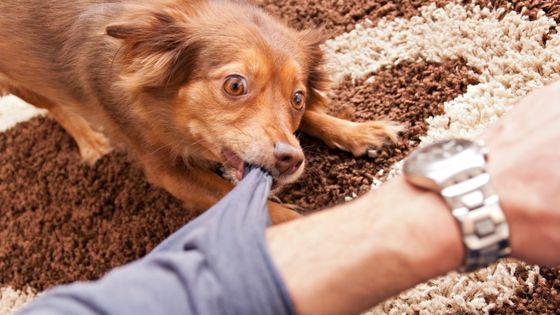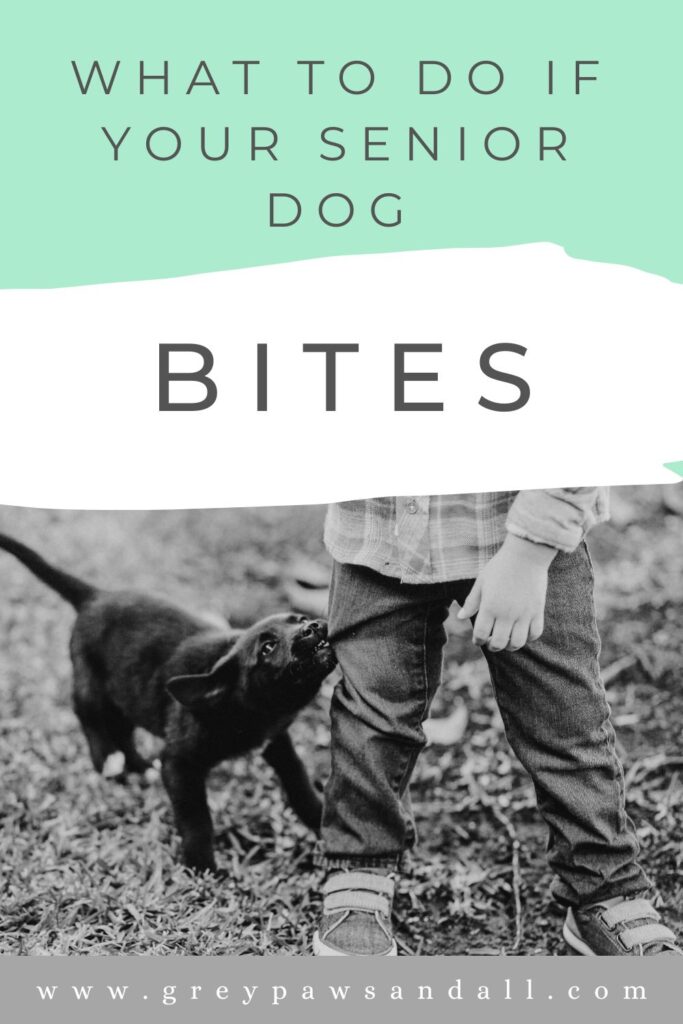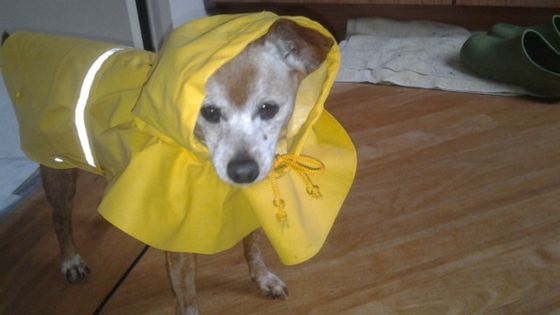There’s a difference between a puppy nipping because he hasn’t learned bite control yet, a dog aggressively going after someone and biting them, and an old dog that bites due to stress, anxiety, pain or vision loss.
If your senior dog suddenly starts biting, I highly recommend you schedule a vet visit as soon as possible. Your dog could be lashing out due to pain, be scared because of vision and/or hearing loss or feeling anxious due to something like dementia for example.
Is It Ever Time to Get Rid of a Dog That Bites?
Sadly there are times when that is the only choice left. Biting needs to be taken seriously, but it also doesn’t mean that should be the first and only decision you make. Every dog is different and so is every situation, and while the reason is often a lack of training, in this article we’re going to be discussing why a senior dog may bite and what you can do about it.
My Experience Living with a Dog That Bites
Several years ago we adopted a dog named Jack who had been abused. His aggressive behavior was definitely fear based and in some situations he would bite. With lots of training, and most importantly an awareness of the triggers, it was something we were able to manage, and he certainly got more mellow with time. Did we have to be more vigilant than others? Yes of course we did because in his case, given the right set of circumstances he would protect himself, but we were okay having to keep a closer eye.
Will Your Dog Warn You Before Biting?
When it comes to signals, there isn’t a set list – some may be obvious while others more subtle.
A tail wag on its own certainly does not mean a dog is going to bite, but paired with other signs it can take on a whole different meaning. By the same token, yawning can signal being nervous or uncomfortable, which doesn’t guarantee it will escalate, certainly not if the dog is removed from that situation.
- Licking lips
- Yawning
- Dog’s tail is up and stiff – early sign that indicates feeling threatened
- Avoiding eye contact
- Growling/snapping/showing his teeth
- Wagging his tail
- Body going rigid
- Ears perked up – could indicate the dog is on edge
- Raised hackles/fur
- See the whites of your dogs eyes
Reasons Why Senior Dogs Bite
- Protecting their resources (known as resource guarding)
- Feel threatened/scared/uncomfortable
- Pain
- Frustration
- Vision loss
- Lack of training/socialization
- Confusion due to dementia
In the following sections we’re going to discuss each reason listed above, and what we can do to help

Resource Guarding
A resource is anything a dog considers to be a treasure, something of high value. It could be toys, food, treats, his bed, people or even territory. Guarding is the behavior exhibited to protect that/those resource(s). It could be running away with the object, a curled lip before the growl begins, chasing the person away, growling, snapping, barking or in extreme causes biting.
It is a very common cause of aggressive behavior including biting, which is why it’s such a big section of this post.
Here are 2 examples of the steps you can take to stop this guarding behavior. It’s very important that you follow any steps in order, and you never move on to the next step too quickly. I know it can be frustrating if it takes a long time, but speeding up a training session usually ends up in setbacks and having it take even longer. It’s also important to be consistent and patient.
NOTE: Do not be afraid or put off by the number of steps you’re seeing. I have purposely written the steps out like this so they will be easier to understand and follow.
Example – toy
◊ Find something your dog likes more than the toy. For the sake of this example I’ll say chicken.
◊ The next time he’s guarding it approach him, but stop well before the distance at which you would typically get a reaction.
◊ Throw him a bit of chicken, then another and leave the room.
◊ Don’t give him any if he comes looking, you want it to be only when he’s with his toy.
◊ Repeat this, taking a step closer when you’re sure he’s comfortable at the previous distance.
◊ Once you’re close to him with no reaction, lean over slightly as though you’re going to take the toy and drop a treat.
◊ Keep repeating this and reaching closer as long as he’s not reacting.
◊ If at any point he does, you’ve progressed too quickly.
Eventually you will be able to pick up the toy. How long is impossible to say, just keep up the training nice and slow. Since your dog has presumably already bitten you when you’ve tried to take a toy away, you must be careful so he doesn’t get to that state again.
Example one – food
Vary feeding times
I always feed my dogs on a schedule. That doesn’t mean the exact some time, but roughly. With some of my dogs, those who loved food, their body clocks put them on alert about a half hour before. For a dog who guards his food, his anxiety is already starting to build for what’s coming. In those cases, varying feeding times can help.
Change where and how he’s fed
Using a different bowl or even filling a Kong with his food may make a difference, as can changing the location of where he eats. It helps break the pattern and as a result, his cycle of anxiety.
You only want positive associations at meal time, and that means your dog learning that when you approach his bowl it’s to give him a delicious treat. This will teach him he has no reason to worry, and nothing is being taken away from him.
Step 1
◊ Pick up your dog’s empty bowl, make it look like you’re putting food in it, then put it on the floor.
◊ When he gives you the “are you having a laugh, what’s with the empty bowl” look, praise him and put some food in.
◊ When he’s eaten it and looks at you again, add some more.
◊ Repeat this until his meal has been eaten.
◊ Walk away, come right back and add a bit more.
Use this technique to feed him each meal for about one week, longer if his guarding behavior is severe. As he becomes more comfortable with you close to his bowl, you’ll be able to put down a full bowl of food and he’ll eat it with you standing next to him. Remember, it takes as long as it needs to take.
Step 2
◊ Walk by the empty bowl and throw a treat of something your dog loves, but doesn’t get all the time.
◊ Do that several times over the course of a week or so. Again, this is showing your dog good things happen when you approach.
Step 3
◊ Throw a treat into his bowl while he’s in the middle of eating his meal.
◊ By this point he should be relaxed enough to eat while near you.
◊ If at any time he appears stressed or begins to show some of that guarding behavior, it means you’ve moved too quickly through the steps. Back up to the point where he was relaxed and progress slower this time.

Example two – food
Step 1
◊ While your dog is eating, stay far enough away so he’s not in guarding mode.
◊ In a fun tone say something like “What’s that?” or “What are you eating?” or whatever sentence you choose.
◊ Throw a treat (again, something he loves but doesn’t get too often) into his bowl. Hopefully the distance you need to be for him to be comfortable and your throwing arm are compatible!! If it misses the bowl do not go and get it, let your dog find it.
◊ Do this a few times throughout his meal. Keep the pieces small so it doesn’t interfere with his regular meal, but not too small that he can’t enjoy it.
◊ Do this at every meal, and do not move to step 2 until your dog has been relaxed while eating in this manner for one week, which should be 14 meals.
◊ If at any point he exhibits, or begins to exhibit guarding behavior, you may be standing too close so take a step or two back and carry on.
◊ It’s very possible at some point during this exercise, your dog will leave his bowl and come looking to you for treats. While that’s a good sign you need to ignore him. The only time he gets the treat is when he’s at his bowl eating.
Step 2
◊ Continue what you’ve been doing in step 1 – asking him what he has and tossing him a treat, but now you’re going to be taking one step forward, tossing the treat, than taking one step back.
Do you see the difference? In step 1 you stood in place as you tossed the treats, in step 2 you’re taking one small step forward, tossing the treat into the bowl, than stepping back.
◊ Every day take one very small step forward.
◊ If at any point your dog is showing guarding behavior, you probably progressed too quickly. Go back to the distance where he was comfortable and instead of taking one step closer every day, try every other day.
Step 3
◊ By this point you should be able to ask him what he has there (or whatever question you’ve come up with), walk up to the bowl, drop a treat in then walk away. Don’t look at your dog, just be cool. Do this for one week of meals then move on…assuming he seems okay.
Step 4
◊ By now your dog should be ready to take a treat from your hand.
◊ While your dog is eating, and repeating the same sentence you decided on in step 1, take a treat in your hand, walk right next to your dog, bend over ever so slightly and encourage him to eat that treat from your hand. Once he does that turn around and walk away. Do this a few times until he finishes his meal.
◊ Repeat this every day, bending just a little bit each time. As you bend, move your hand ever so slightly closer to the bowl. Repeat this until your dog is relaxed enough to allow you to give him a treat with your hand next to his food bowl. Do this for about one week, and when he’s ready move to step 5.
Step 5
◊ The goal of this step is for you to be able to touch his bowl with one hand, while you give him a treat with the other.
◊ As before, once the treat is given turn around and walk away.
◊ Repeat several times.
◊ Remain at this step until you can touch his bowl during about a week of meals, and he’s relaxed.
Step 6
◊ Approaching your dog with your usual greeting, stand next to him, bend over to pick up the bowl, raise it just a few inches off the ground, drop a treat in it, put it back down and walk away.
◊ Repeat several times.
Step 7
◊ Do the same as in step 6, but now you’ll be raising the bowl higher off the ground to put the treat in. Place it back down on the floor for your dog to eat. You want to be able to stand straight while holding the bowl.
Step 8
◊ You are now able to reach down, pick your dog’s food bowl up off the floor and he’s okay with that.
◊ Now you’re going to walk over to the counter, put the treat in the bowl over there, return the bowl to your dog and repeat.
Step 9
◊ Everyone who lives in your home has to go through steps 1-8, but one person at a time.
I know it’s a lengthy process, but breaking the training into tiny little steps done over a lengthy period of time increases the chances of success.

Feeling Threatened, Scared or Uncomfortable
These feelings can cause a dog to become aggressive (known as fear aggression), and if the situation isn’t dealt with properly, it could result in your dog biting you or someone else.
The first thing a dog wants to do when in a situation like this is run away. If he can’t get away from what’s scaring him or making him uncomfortable, he has to stay and either hope the threat goes away or fight. You’re familiar with the “fight or flight” response right?
This type of aggression is often the result of lack of training and socialization, and of course can be caused by abuse in the dog’s past.
There isn’t a cure for this, but it certainly can be managed and here’s how.
Pay attention to triggers: When you’ve figured out which situations trigger that aggressive response, do what you can to avoid them as much as possible.
Don’t pet the top of your dog’s head: Some dogs, especially those that have been abused, may fear a hand coming down on them.
Keep your distance: At what distance does your dog tend to get aggressive, then stay beyond that when you can.
Create a calm environment: A more predictable and calm environment will do a lot to keep your dog’s anxiety level down.
Build confidence through training: Teach your dog how to sit and stay, or hire a qualified and experienced trainer to help. They will also help you deal with the triggers in an effective way.
Avoid competition for toys: If you live in a multi dog household, provide enough toys and treats for everyone.
Natural anti-anxiety products: Rescue Remedy, Valerian, Valerian with Skullcap, CBD oil, dog calming music on Youtube, pheromone plug in or spray such as Adaptil.
For more recommendations please read this article ⇒ 22 Natural Ways to Calm Your Anxious Dog

A dog May Bite If in Pain
If a dog is in pain there’s a pretty good chance he’s going to bite, especially if the painful area is touched. If he’s protecting a certain part of his body and it looks like you’re getting too close, he may air snap to keep you away.
You’ll need to see your vet as soon as possible in order to determine what’s going on, so appropriate medication can be prescribed. Once the issue has been dealt with, biting should end. If the condition is long term like arthritis for example, it will be important to keep a close eye on him and find the right combination of treatments to make your dog as comfortable as possible.
This article (5 Effective Ways to Reduce Pain in Dogs with Arthritis) is filled with lots of helpful suggestions to manage pain. Please be sure to speak with your vet before trying something new!
Frustration
Biting due to frustration is another form of aggression, which I talked about above. Your dog may be trying to get to something but is being held back by you, a leash or even a barrier. That frustration can lead your dog to lash out in the form of a bite.
Knowing what situations trigger these episodes of frustration means you can avoid them. Of course you should also get a professional and experienced trainer or behaviorist involved to help, because you can’t spend your life ducking all kinds of situations.

Vision Loss
Not every dog who is losing their sight will become aggressive and bite, but many do. Imagine how scary it is not understanding what’s going on. You reach over to pet your dog, but he sees something blurry coming at him. He’s resting in his bed and you appear and startle him. That fear is what’s causing him to bite. Don’t worry it won’t always be like that, what’s important is you do what you can to help your dog adjust to his sudden or gradual loss of sight.
Although my dog Red (wearing the cute yellow raincoat above!) was already blind when I adopted her, there are plenty of things I learned along the way about helping her be safe and comfortable.
◊ Don’t move furniture around. If you need a change, buy a new pillow for the couch or accessory.
◊ Be mindful of toys on the floor she can stumble over and injure himself.
◊ Leave the water bowl where it is, and add one or two more if you feel it would help.
◊ If she needs a bed washed or replaced, don’t leave the spot empty. Put a blanket down she she knows she’s in the right place.
◊ Teach your dog the word “careful.” When my dog would bang into something I would say “careful” and she learned to immediately stop and change direction whenever she heard it.
◊ If your dog is sleeping on the couch and you have to leave the room, even if only for a second, put a chair against it so she doesn’t fall off. A second is rarely just that.
◊ If I had to wake her up for some reason I called her name first or very gently touched her to get her attention. I did my best to never startle her.
◊ Be careful of leaving doors open if there are stairs she can fall down, and that applies to both in the house and out.

◊ I put foam pieces (slit pipe insulation vertically in the picture above) on the edges of doors and around table legs at her head level, so if she bumped into them the foam would cushion her.
◊ I never closed doors she knew were always open. Having said that, do close them or use baby gates if they lead to stairs.
What To Do When Your Dog Plays Too Rough
Some dogs get so excited about playing, they end up being quite rough. They may jump up on you and others, and that includes children, and can bite. It may not be aggressive behavior, but it can cause pain or injury. Other dogs may not want to play with him either because of it.
You can teach your dog to not play so rough, but he needs to have a basic foundation in obedience such as sit, stay, come and definitely how to walk nicely on a leash.
Start noticing the cues your dog is giving when he starts to get too excited, then interrupt it. Whether that’s getting his attention and asking him to sit, giving him a treat or putting the leash back on. Some dogs may grab your clothes or hand when playing, and again, it’s not aggressive but it’s still a bite so give him a toy instead. Be sure your kids don’t play rough with him either.
Lack of Training/Socialization
As you’ve seen throughout this post, many instances are a result of lack of training and learning how to socialize with others. Start with teaching your dog the basic commands and go from there. Again there are a ton of helpful resources online if you prefer doing it yourself, or get some tips from a trainer.
Confusion Due to Dementia
Many old dogs will get dementia, and with that often comes anxiety. Although biting is not necessarily a common symptom it can happen as a result of the confusion your dog is experiencing. Add fading eyesight and it’s a definite possibility. When you notice behavior changes in dogs of any age, but particularly older dogs, it’s important to have them seen by a vet right away. There are treatment options to help manage the symptoms, which can reduce/eliminate the biting behavior as well.
Here are links to some helpful articles about dementia including signs to look out for, and treatment recommendations.
A Comprehensive Guide to Dog Dementia
Does Your Senior Dog Have Dementia

How to Prevent a Dog From Biting You or Your Children
These are general dog bite prevention tips.
◊ Don’t approach dogs you don’t know, especially if they are tied up, in a car or yard
◊ Don’t bother a dog when he’s sleeping or eating
◊ Don’t start petting a dog you don’t know unless he sees you and sniffs you first
◊ If you suddenly come into a contact with a potentially aggressive dog, stay still. Avoid eye contact and keep your hands by your sides. He should lose interest in you then back away until you can no longer see him
If your dog is afraid of children, read this ⇒ Why is My Old Dog Afraid of Kids
Protecting Yourself If a Dog Attacks
- Ignore him
- Avoid contact
- Keep your arms still and by your side
To learn more about the steps you can take, read this ⇒ What to Do When a Dog Attacks
Please do not hit or punish your dog, because that is never the answer. In fact, it will only make the situation worse. Also, don’t turn a blind eye and hope the biting issue resolves itself, because it won’t.
If you’re looking for a community of senior dog parents, a place where you can find helpful tips, support and people who “get it” please join my FB group Senior Dog Care Club
I help senior dog parents struggling with anticipatory grief and quality of life issues by offering practical tips, advice and one on one support. I am also a Certified Pet Loss Grief Support Coach, helping you navigate through your pet loss journey.
Visit my services page to book a FREE 20 minute discovery call, or email me (Hindy) at hpearson141@gmail.com if you have any questions.
I’ve been rescuing and caring for senior dogs since 2009. From vision and hearing loss to obesity, dementia, kidney disease, liver issues, cardiac problems, Cushing’s, mobility challenges and more, you could say I’ve dealt with and learned a lot! In addition to my hands on experience, I’ve taken many courses and earned several qualifications to keep learning how to help senior dogs and they include: Senior Dog Enrichment, Understanding Canine Anxiety, Care of the Senior Pet and I’m a Certified Pet Loss Specialist.
